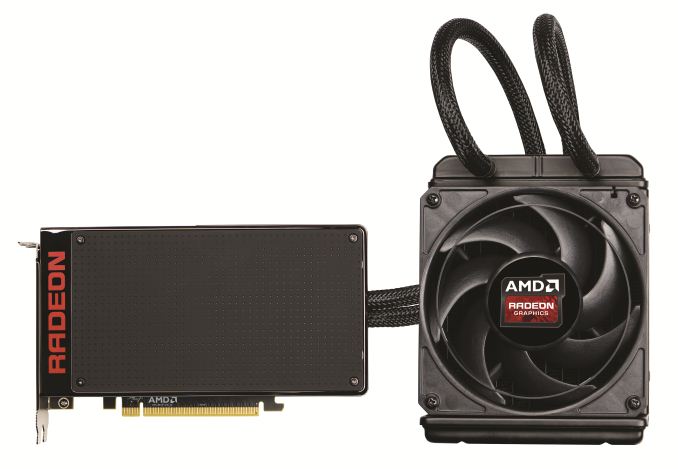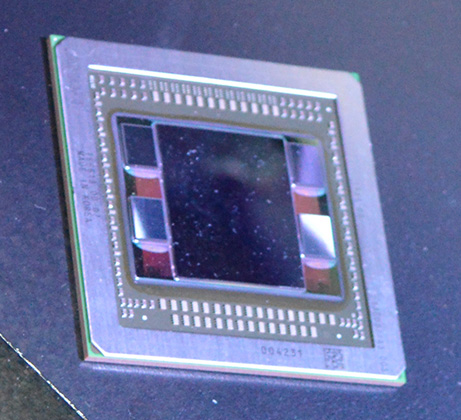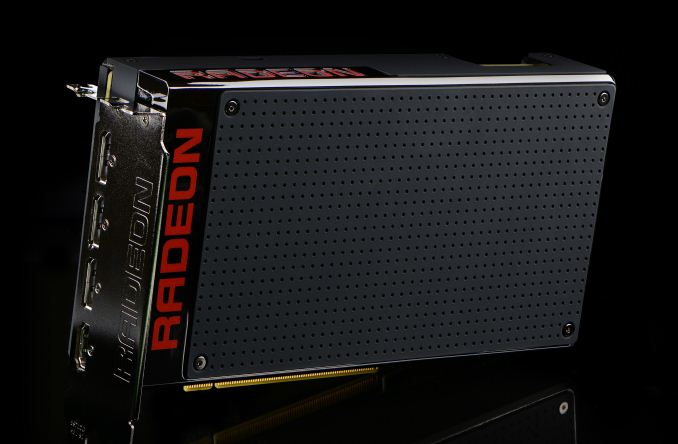The AMD Radeon R9 Fury X Review: Aiming For the Top
by Ryan Smith on July 2, 2015 11:15 AM EST
Almost 7 years ago to this day, AMD formally announced their “small die strategy.” Embarked upon in the aftermath of the company’s struggles with the Radeon HD 2900 XT, AMD opted against continuing to try beat NVIDIA at their own game. Rather than chase NVIDIA to absurd die sizes and the risks that come with it, the company would focus on smaller GPUs for the larger sub-$300 market. Meanwhile to compete in the high-end markets, AMD would instead turn to multi-GPU technology – CrossFire – to offer even better performance at a total cost competitive with NVIDIA’s flagship cards.
AMD’s early efforts were highly successful; though they couldn’t take the crown from NVIDIA, products like the Radeon HD 4870 and Radeon HD 5870 were massive spoilers, offering a great deal of NVIDIA’s flagship performance with smaller GPUs, manufactured at a lower cost, and drawing less power. Officially the small die strategy was put to rest earlier this decade, however even informally this strategy has continued to guide AMD GPU designs for quite some time. At 438mm2, Hawaii was AMD’s largest die as of 2013, still more than 100mm2 smaller than NVIDIA’s flagship GK110.

AMD's 2013 Flagship: Radeon R9 290X, Powered By Hawaii
Catching up to the present, this month marks an important occasion for AMD with the launch of their new flagship GPU, Fiji, and the flagship video card based on it, the Radeon R9 Fury X. For AMD the launch of Fiji is not just another high-end GPU launch (their 3rd on the 28nm process), but it marks a significant shift for the company. Fiji is first and foremost a performance play, but it’s also new memory technology, new power optimization technologies, and more. In short it may be the last of the 28nm GPUs, but boy if it isn’t among the most important.
With the recent launch of the Fiji GPU I bring up the small die strategy not just because Fiji is anything but small – AMD has gone right to the reticle limit – but because it highlights how the GPU market has changed in the last seven years and how AMD has needed to respond. Since 2008 NVIDIA has continued to push big dies, but they’ve gotten smarter about it as well, producing increasingly efficient GPUs that have made it harder for a scrappy AMD to undercut NVIDIA. At the same time alternate frame rendering, the cornerstone of CrossFire and SLI, has become increasingly problematic as rendering techniques get less and less AFR-friendly, making dual GPU cards less viable than they once were. And finally, on the business side of matters, AMD’s market share of discrete GPUs is lower than it has been in over a decade, with AMD’s GPU plus APU sales now being estimated as being below just NVIDIA’s GPU sales.
Which is not to say I’m looking to paint a poor picture of the company – AMD Is nothing if not the perennial underdog who constantly manages to surprise us with what they can do with less – but this context is important in understanding why AMD is where they stand today, and why Fiji is in many ways such a monumental GPU for the company. The small die strategy is truly dead, and now AMD is gunning for NVIDIA’s flagship with the biggest, gamiest GPU they could possibly make. The goal? To recapture the performance crown that has been in NVIDIA’s hands for far too long, and to offer a flagship card of their own that doesn’t play second-fiddle to NVIDIA’s.
To get there AMD needs to face down several challenges. There is no getting around the fact that NVIDIA’s Maxwell 2 GPUs are very well done, very performant, and very efficient, and that between GM204 and GM200 AMD has their work cut out for them. Performance, power consumption, form factors; these all matter, and these are all issues that AMD is facing head-on with Fiji and the R9 Fury X.
At the same time however the playing field has never been more equal. We’re now in the 4th year of TSMC’s 28nm process and have a good chunk of another year left to go. AMD and NVIDIA have had an unprecedented amount of time to tweak their wares around what is now a very mature process, and that means that any kind of advantages for being a first-mover or being more aggressive are gone. As the end of the 28nm process’s reign at the top, NVIDIA and AMD now have to rely on their engineers and their architectures to see who can build the best GPU against the very limits of the 28nm process.
Overall, with GPU manufacturing technology having stagnated on the 28nm node, it’s very hard to talk about the GPU situation without talking about the manufacturing situation. For as much as the market situation has forced an evolution in AMD’s business practices, there is no escaping the fact that the current situation on the manufacturing process side has had an incredible, unprecedented effect on the evolution of discrete GPUs from a technology and architectural standpoint. So for AMD Fiji not only represents a shift towards large GPUs that can compete with NVIDIA’s best, but it represents the extensive efforts AMD has gone through to continue improving performance in the face of manufacturing limitations.
And with that we dive in to today’s review of the Radeon R9 Fury X. Launching this month is AMD’s new flagship card, backed by the full force of the Fiji GPU.
| AMD GPU Specification Comparison | ||||||
| AMD Radeon R9 Fury X | AMD Radeon R9 Fury | AMD Radeon R9 290X | AMD Radeon R9 290 | |||
| Stream Processors | 4096 | (Fewer) | 2816 | 2560 | ||
| Texture Units | 256 | (How much) | 176 | 160 | ||
| ROPs | 64 | (Depends) | 64 | 64 | ||
| Boost Clock | 1050MHz | (On Yields) | 1000MHz | 947MHz | ||
| Memory Clock | 1Gbps HBM | (Memory Too) | 5Gbps GDDR5 | 5Gbps GDDR5 | ||
| Memory Bus Width | 4096-bit | 4096-bit | 512-bit | 512-bit | ||
| VRAM | 4GB | 4GB | 4GB | 4GB | ||
| FP64 | 1/16 | 1/16 | 1/8 | 1/8 | ||
| TrueAudio | Y | Y | Y | Y | ||
| Transistor Count | 8.9B | 8.9B | 6.2B | 6.2B | ||
| Typical Board Power | 275W | (High) | 250W | 250W | ||
| Manufacturing Process | TSMC 28nm | TSMC 28nm | TSMC 28nm | TSMC 28nm | ||
| Architecture | GCN 1.2 | GCN 1.2 | GCN 1.1 | GCN 1.1 | ||
| GPU | Fiji | Fiji | Hawaii | Hawaii | ||
| Launch Date | 06/24/15 | 07/14/15 | 10/24/13 | 11/05/13 | ||
| Launch Price | $649 | $549 | $549 | $399 | ||
With 4096 SPs and coupled with the first implementation of High Bandwidth Memory, the R9 Fury X aims for the top. Over the coming pages we’ll get in to a deeper discussion on the architectural and other features found in the card, but the important point to take away right now it that it packs a lot of shaders, even more memory bandwidth, and is meant to offer AMD’s best performance yet. R9 Fury X will eventually be joined by 3 other Fiji-based parts in the coming months, but this month it’s all about AMD’s flagship card.
The R9 Fury X is launching at $649, which happens to be the same price as the card’s primary competition, the GeForce GTX 980 Ti. Launched at the end of May, the GTX 980 Ti is essentially a preemptive attack on the R9 Fury X from NVIDIA, offering performance close enough to NVIDIA’s GTX Titan X flagship that the difference is arguably immaterial. For AMD this means that while beating GTX Titan X would be nice, they really only need a win against the GTX 980 Ti, and as we’ll see the Fury X will make a good run at it, making this the closest AMD has come to an NVIDIA flagship card in quite some time.
Finally, from a market perspective, AMD will be going after a few different categories with the R9 Fury X. As competition for the GTX 980 Ti, AMD is focusing on 4K resolution gaming, based on a combination of the fact that 4K monitors are becoming increasingly affordable, 4K Freesync monitors are finally available, and relative to NVIDIA’s wares, AMD fares the best at 4K. Expect to see AMD also significantly play up the VR possibilities of the R9 Fury X, though the major VR headset, the Oculus Rift, won’t ship until Q1 of 2016. Finally, it has now been over three years since the launch of the original Radeon HD 7970, so for buyers looking for an update AMD’s first 28nm card, Fury X is in a good position to offer the kind of generational performance improvements that typically justify an upgrade.












458 Comments
View All Comments
Scali - Tuesday, July 7, 2015 - link
Even better, there are various vendors that sell a short version of the GTX970 (including Asus and Gigabyte for example), so it can take on the Nano card directly, as a good choice for a mini-ITX based HTPC.And unlike the Nano, the 970 DOES have HDMI 2.0, so you can get 4k 60 Hz on your TV.
Oxford Guy - Thursday, July 9, 2015 - link
28 GB/s + XOR contention is fast performance indeed, at half the speed of a midrange card from 2007.Gothmoth - Monday, July 6, 2015 - link
so in short another BULLDOZER.... :-(after all the hype not enough and too late.
i agree the card is not bad.. but after all the HYPE it IS a disappointment.
OC results are terrible... and AMD said it will be an overclockers dream.
add to that that i read many complains about the noisy watercooler (yes for retail versions not early preview versions).
iamserious - Monday, July 6, 2015 - link
It looks ugly. Loliamserious - Monday, July 6, 2015 - link
Also. I understand it's a little early but I thought this card was supposed to blow the GTX 980Ti out of the water with it's new memory. The performance to price ratio is decent but I was expecting a bit larger jump in performance increase. Perhaps with the driver updates things will change.Scali - Tuesday, July 7, 2015 - link
Hum, unless I missed it, I didn't see any mention of the fact that this card only supports DX12 level 12_0, where nVidia's 9xx-series support 12_1.That, combined with the lack of HDMI 2.0 and the 4 GB limit, makes the Fury X into a poor choice for the longer term. It is a dated architecture, pumped up to higher performance levels.
FMinus - Tuesday, July 7, 2015 - link
Whilst it's beyond me why they skimped on HDMI 2.0 - there's adapters if you really want to run this card on a TV. It's not such a huge drama tho, the cards will drive DP monitors in the vast majority, so, I'm much more sad at the missing DVI out.Scali - Wednesday, July 8, 2015 - link
I think the reason why there's no HDMI 2.0 is simple: they re-used their dated architecture, and did not spend time on developing new features, such as HDMI 2.0 or 12_1 support.With nVidia already having this technology on the market for more than half a year, AMD is starting to drop behind. They were losing sales to nVidia, and their new offerings don't seem compelling enough to regain their lost marketshare, hence their profits will be limited, hence their investment in R&D for the next generation will be limited. Which is a problem, since they need to invest more just to get where nVidia already is.
It looks like they may be going down the same downward spiral as their CPU division.
sa365 - Tuesday, July 7, 2015 - link
Well at least AMD aren't cheating by allowing the driver to remove AF despite what settings are selected in game. Just so they can win benchmarks.How about some fair, like for like benchmarking and see where these cards really stand.
FourEyedGeek - Tuesday, July 7, 2015 - link
As for the consoles having 8 GB of RAM, not only is that shared, but the OS uses 3 GB to 3.5 GB, meaning there is only a max of 5 GB for the games on those consoles. A typical PC being used with this card will have 8 to 16 GB plus the 4 GB on the card. Giving a total of 12 GB to 20 GB.In all honesty at 4K resolutions, how important is Anti-Aliasing on the eye? I can't imagine it being necessary at all, let alone 4xMSAA.